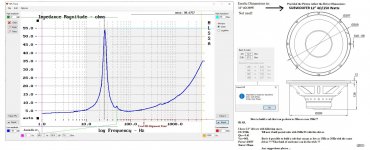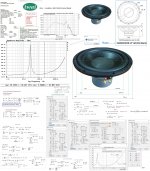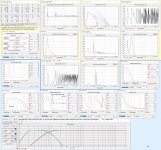Here is the Hornresp input data if someone wants to play with this idea or make a drawing.
What I would really like to know is how you managed to get a value of 1.4908850 to appear in the disabled Fta text box. It should be 0,00 🙂.
What is the Frame Diameter
Hi audfrknaveen,All
No Help Posted hereinafter/above but my Fingers are crossed(Sd and x max is probably both stretched...) and continuing being back on Topic! Pictures may Help:
b 🙂
Hi wonderfulaudio,All
You're correct.Without doing a Consistency Check and an educated guestimated calculation of Driver Sd and Xmax from a Ruler Measurement of the Driver Frame Width and the Rubber Surround Diameter) : The given Data could be way off and sculptured to impress any ignorant Layman.
So What is the Frame Diameter?
b🙂
Hi audfrknaveen,All
No Help Posted hereinafter/above but my Fingers are crossed(Sd and x max is probably both stretched...) and continuing being back on Topic! Pictures may Help:
b 🙂
Attachments
Check out Rod Elliott's site #48 and 71...subwoofer control, etc.I saw this thread.
15HZ Sub (you can build in an hour)
But unfortunately the images are not opening. It's a very old thread. Anybody knows the design ??
sound-au.com
Looks like the link won't work. Just google Rod Elliott Sound and it will take you there.
Last edited:
What I would really like to know is how you managed to get a value of 1.4908850 to appear in the disabled Fta text box. It should be 0,00
I don't know, but I suspect that running Hornresp in Proton (Steam windows compatibility layer) might be the cause.
Proton (compatibility layer) - Wikipedia
GitHub - ValveSoftware/Proton: Compatibility tool for Steam Play based on Wine and additional components
I don't know, but I suspect that running Hornresp in Proton (Steam windows compatibility layer) might be the cause.
I guess that probably doesn't help things much... 🙂.
It is still quite weird though, how it managed to generate a value out of nothing, and use a period rather than a comma as the decimal separator 🙂.
Audfrknaveen,
1.Have you tried open baffle yet? If you have a capable amplifier (a proper PA amp with at least 200-300 watts per channel) and parametric eq, it would be viable to at least try. I have recently got a pair of very generic 12" woofers, in my 14 square meter room i get very satisfying, precise and tactile bass - to put this statement into perspective, consider that i am a bass addict, and i enjoy being pounded by 8 or more 18" woofers at events.....
Of course the experience with my open baffle woofers does not come close to that, but when the woofers have a good excursion workout, i get a good feeling of impacteasily down to 30 hz. Even below that I am still getting something..... i have test tracks that go down to 19 hz.
2. R-J (robbins joseph) enclosure RJ8
This enclosure type is supposed to reduce turbulence and distortion of woofers driven below tuning.
3. Nozzle port /tuyere acoustique. There are some french research papers that show a similar effect as the r-j enclosure claims to have, but backed up with thorough measurement data.
1.Have you tried open baffle yet? If you have a capable amplifier (a proper PA amp with at least 200-300 watts per channel) and parametric eq, it would be viable to at least try. I have recently got a pair of very generic 12" woofers, in my 14 square meter room i get very satisfying, precise and tactile bass - to put this statement into perspective, consider that i am a bass addict, and i enjoy being pounded by 8 or more 18" woofers at events.....
Of course the experience with my open baffle woofers does not come close to that, but when the woofers have a good excursion workout, i get a good feeling of impacteasily down to 30 hz. Even below that I am still getting something..... i have test tracks that go down to 19 hz.
2. R-J (robbins joseph) enclosure RJ8
This enclosure type is supposed to reduce turbulence and distortion of woofers driven below tuning.
3. Nozzle port /tuyere acoustique. There are some french research papers that show a similar effect as the r-j enclosure claims to have, but backed up with thorough measurement data.
To reach 15 Hz with som useful sound preassure I would suggest 4 closed boxes with a Qb = 0,5 or less. Eq will have to be used to extend low frequenzies. More boxes will give less distorsion and or more output.
Will this driver work w/little danger of blowing? Three of these in separate closures will share a 20X20 space* w/a10’ ceiling.Hard to find a driver with matching specs, but a Dayton Audio RSS315HF-4 comes close although it has double power.
In WinISD it is tunable to F3=17 Hz in a 0,23 m^3 box and a 200 cm^2 port with 783 mm length. 107 dB@200W. No too flat, but will work. At 15 Hz still 104dB.
*cut off from the rest of the house
RSS315hf-8 ohm model, sealed*; a little EQ for target F3 of 20hz, low-passed @ ~40hz**, slope to be determined.
*recommend size?
** yes - severely band limited
PE’s preferred Boxpro(?) projects an F3 40hz, no EQ. WinISD models differently.
Many thanks in advance for your help. Tony
If this is for music, only the last peddle on an organ goes down to 16hz and that is more felt than heard. If you are getting 28hz F3 than you are covering 99.999% of the music spectrum. Below 28hz I'd look at shakers.
75% home theater though prefer sealed for music & accuracy’s sake (it’s complicated)If this is for music, only the last peddle on an organ goes down to 16hz and that is more felt than heard. If you are getting 28hz F3 than you are covering 99.999% of the music spectrum. Below 28hz I'd look at shakers.
Recommended closure size? Ultimately my LR will each have their own, a third handling LFE. Each surround* has a dedicated sub** good to 27hz** before room gain.
*7.X system
**meets specs
Perhaps extreme, my illness. Thanks for your patience & help. Tony
- Home
- Loudspeakers
- Subwoofers
- How to build a sub that can go down to 20hz or even 15Hz??


